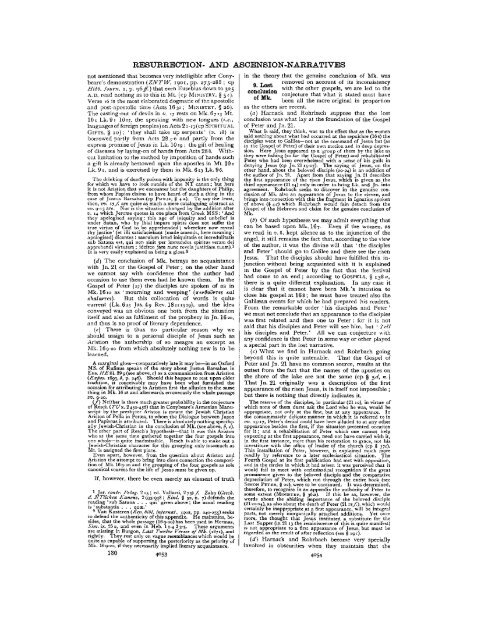cheenc03a.pdf
cheenc03a.pdf
cheenc03a.pdf
Create successful ePaper yourself
Turn your PDF publications into a flip-book with our unique Google optimized e-Paper software.
RESURRECTION- AND 1 SCENSION-NARRATIVES<br />
not mentioned that becomes very intelligible after Conybeore's<br />
demotlstration (ZNTW, 1901, pp. 275.288 : cp<br />
Hiab. /our". I. p. 96s) that evrn Eusebsui down to 325<br />
A.D. read nothlng as to this in hilt. (cp Mi~lsTnY, 5 jc).<br />
Verse 16 is the most elaborated dogmatic of the ipostollc<br />
and port~apostolic time (Acts 16ji ; M~x~sTnr, 8 26).<br />
he casting-our of devllr in u. XI rests on Mk. 6/13 Mt.<br />
10, Lk. 9 1 lor,, the speaking with new tongues (i.e.,<br />
lallguagesof foreign peop1es)on ~ cts 2 ~ ~ ~ SpmmuaL ~ ( c p<br />
G~rrs, ; ' thq shall take up serpents' (u. 18) is<br />
8 10)<br />
borrowed partly from Acts 28 3 ~6<br />
and partly from the<br />
express promise of Jesus in Lk. 1019 ; thr gift of healing<br />
of diseases by laying-on of hands from Acts 288. U'ithout<br />
limitation to the mcthod by imposition of hands such<br />
n gift ir already bestowed upon the apostles in Mt. 101<br />
Lk. 9 r, and is exercised by then, in .Mk. 613 Lk. 96.<br />
in the theory that the genuine conclusion of Mk. was<br />
. - . removed on account of its inco~rairlencv<br />
c&E& with the other gospels, we are led to t'<br />
conjecture that what it stated must have<br />
of mk been all the more oiieinai in oronortian<br />
as the others are recent.<br />
(a) IIvrnack and Rohrbach suppose that the lost<br />
conclusion was what 1s" at the foundation of the Ciosoel<br />
- . ~ ~ ~ . ~ ~ ~<br />
(dl The conclusion of Mk. betrays no acquaintance<br />
with Jn. 21 or the Gospel of Peter ; on the other hand<br />
we wnnot ray with confidence that the author had<br />
occasion to use them even had he known them. In the<br />
Gospel of Peter (z,) the disciples are spoken of as in<br />
Mk. 16.0 as 'mourning and weeping' (irsuBoQ~rr xal<br />
~hoiovrrr). Rut this collocation of words ie quite<br />
current (Lk. 6zj Ja6.49 Rev. 18rlr5z9), and the idea<br />
conveyed war an obvious one both from the ritualion<br />
itself and also as fulfilment of the prophecy in Jn. 1610,<br />
and thus ir no proof of literary . dependence. .<br />
(8) There & thus no particular reason why ~ve<br />
should assign to a personal disciple of Jcsur such as<br />
Aristion the authorship of so meagre an excerpt an<br />
hlk. 169-20 from which abroluteiy nothing new is to be<br />
learned.<br />
"a. 9-so.<br />
y) Ncither ir there much greater probability in theconjecture<br />
of R~s~h(7'Ux. 2450.456) Ihrt in Conybeare'r Almenlrn<br />
script by the re.b,ter Ariaton ir meant thc Jewrrh Chrlrtian<br />
Adrtan of pel& in towhom the Dialogue between Jnron<br />
and Papiscur is attriburcd. There is ~brolulely nothing specific.<br />
ally JewirhChrirrian in the conslurion of Mk.(ree above 6 c).<br />
The other part of Rexhr hypothesis-thrr it war this<br />
who ar the rame rime togcrh~r the four gospels into<br />
onc whoie-is quite inrdmirriblc. Rerch irablr to make out n<br />
ew>,h-Chnsllnn . character for this grouping only inromvch as<br />
'<br />
It. ir rrslgned the firrr plrce.<br />
Even apart, however. from the question abou, Arirton and<br />
Arirtion the attempt to bring into clor~ connection the compasition<br />
of hlk.IBg-zo and thc grouping of ,he four gospels as role<br />
canoneal sou.ces for ,he lire jsrul muer be given up.<br />
If, however, there be even merely an element of truth<br />
(b) Of such hypotheses we may admit everything that<br />
can be bared upon Mk.16~. Even if the women, as<br />
r e read in v. 8. kept silence as to the injunction of the<br />
angel, it still remains the fact that, accordingto the view<br />
of the author, it was the divine will that 'the disciples<br />
and Peter' should go to Galilee and there see the rlsen<br />
Jesus. That the disciples should hare fulfilled this injunction<br />
without being acquninted with it is explained<br />
in the Gospel of Peter by the fact that the festival<br />
had come to an end; according to GOSPELS, g 1 ~ o. 8<br />
there is a quite diRerent explanation. In any case it<br />
is clear that it cannot have been Mk'r intct~tion to<br />
close his gospel at 168 ; he must have treated also the<br />
Galilzean events fur which he had prepared his renders.<br />
From the remarkable order 'his dircioles and Peter'<br />
we must not concinde that an appearance to the disciples<br />
was first related and then one to Peter: for it is not<br />
said that his disciples and Peter will see him, but , ?el(<br />
his disciples and Peter.' All we can conjecture i%ith<br />
any confidence is that Peter in someway or other played<br />
a special part in the lost narrative.<br />
(c) What we find in Hnrnack and Rohrbach going<br />
beyond this is quite untenable. That the Gospel uf<br />
Peter and Jn. 21 have no common source, results at the<br />
outset front the fact that the names of the apostles on<br />
the shore of the lake are not the same (cp 5 gd, n.)<br />
That Jn. 21 originally war a description of the first<br />
appearance of the risen Jesus, ir in itself not impossible ;<br />
but there is nothing that directly indicates it.<br />
Id) Harnack and Rohrbach become very specially<br />
involved in obscurities when they maintain that the<br />
4054
















